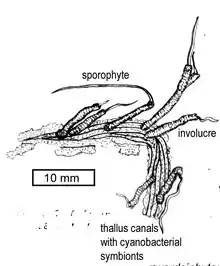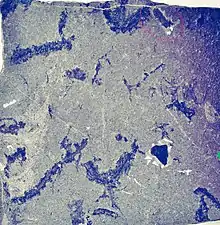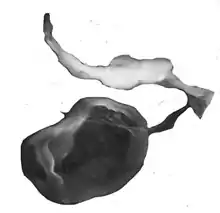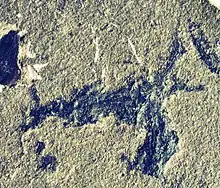Casterlorum
Casterlorum ("Caster's whip") is a genus of fossil with controversial interpretation from the Middle Ordovician (Darriwilian, 460 million years old) Douglas Lake Member of the Lenoir Limestone from Douglas Dam Tennessee[1] The genus was named in honor of Ken Caster.



| Casterlorum Temporal range: | |
|---|---|
 | |
| Holotype of Casterlorum crispum, from the Douglas Lake Member of Lenoir Limestone, at Douglas Dam, Tennessee[1] | |
| Scientific classification | |
| Kingdom: | |
| Division: | |
| Class: | |
| Order: | |
| Family: | |
| Genus: | Casterlorum Retallack (2019) |
| Type species | |
| Casterlorum crispum Retallack (2019) | |
Description
Casterlorum was interpreted a hornwort by Gregory Retallack. Casterlorum has a wide dichotomizing gametophyte thallus with dichotomizing dark lines interpreted as mucilage canals with cyanobacterial symbionts. The sporophyte horns have a thick basal involucre and when dehisced form whip like curls. Spores are small and laevigate.
Interpretation
Hornworts of such antiquity have been considered controversial because heavily ornamented spores like those of Anthoceros have not been found among Ordovician spore assemblages.[2] The spores of Casterlorum are small and smooth, like those of the living hornwort Leiosporoceros, which is considered basal to the family tree of hornworts.[3] The hornwort interpretation of this fossil has been contested by some,[4] but accepted elsewhere [5]
References
- Retallack, G.J. (2019). "Ordovician land plants and fungi from Douglas Dam, Tennessee". The Palaeobotanist. 68: 1–33.
- Wellman, Charles H.; Cascales-Miñana, Borja; Servais, Thomas (2023). "Terrestrialization in the Ordovician". Geological Society, London, Special Publications. 532 (1): 1–20. doi:10.1144/SP532-2022-92. S2CID 253011815.
- Duff, R. Joel; Villareal, Juan Carlos; Cargill, D. Christine; Renzaglia, Karen S (2007). "Progress and challenges toward a phylogeny and classification of the hornworts". The Bryologist. 110 (2): 214–243. doi:10.1639/0007-2745(2007)110[214:PACTDA]2.0.CO;2. S2CID 85582943.
- Edwards, Dianne; Morris, Jennifer L.; Axe, Lindsey; Duckett, Jeffrey G.; Pressel, Silvia; Kenrick, Paul (2022). "Piecing together the eophytes – a new group of ancient plants containing cryptospores". New Phytologist. 233 (3): 1440–1455. doi:10.1111/nph.17703. ISSN 0028-646X. PMID 34806774. S2CID 244495761.
- Leigh, Egbert (2022). "Fossil soils: trace fossils of ecosystems on land and windows on the context of evolution". Evolution Education and Outreach. 15:14: 1–5. doi:10.1186/s12052-022-00173-3. S2CID 252203727.